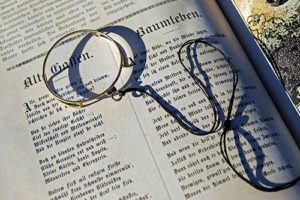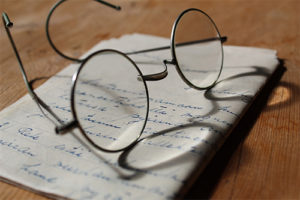The History of Glasses

From “reading stones” to cutting edge technology – how history has shaped your spectacles.

It’s hard to imagine a world without certain things. The internet, cellphones, cars … but imagine how differently we would experience all of these things if the humble spectacles had never been invented?
Imagine trying to see the world through an emerald, as Roman Emperor Nero apparently did, or holding up a piece of quartz secured in bone, as a magnifying glass?
This month, we take a step back in time to look through some of the fascinating revisions that spectacles went through to get to how we know them today. Next time you curse your glasses for fogging up or slipping off your nose, start thinking about how they might evolve in the next few hundred years!
In the early days, we used water and rocks …
We don’t know when exactly people first started using reading aids, but we do know that scholars in Ancient Rome used globes of water to make it easier to read their texts. These magnification devices may have been some of the earliest examples of people utilising natural resources as reading aids.
Further, Roman Emperor Nero reportedly relied on an emerald to help him watch gladiator fights in the Colosseum. Modern scholars suppose this could have served as both a UV filter and magnifier, like an ancient polarised prescription lens!
Crystals and clear vision …
 Beginning around the early 1200’s, polished quartz crystals were popularised as “reading stones” by scholars and monks. Some descriptions of these early lenses still exist in the works of Ptolemy and Ibn Sahl (10th century), which served as the basis for developments of the art and science of optics.
Beginning around the early 1200’s, polished quartz crystals were popularised as “reading stones” by scholars and monks. Some descriptions of these early lenses still exist in the works of Ptolemy and Ibn Sahl (10th century), which served as the basis for developments of the art and science of optics.
Reading stones took off in the monastic communities of Europe, especially among older monks who suffered from poor eyesight, and were thankful to now be able to read the scriptures again. In these early days, only monks and scholars had a need for reading aids as most of the general population were illiterate, and accepted declining vision as a regular part of life and aging.
Italian craftsmen created eyeglasses …
 In the 13th Century, northern Italy became a hub of glass manufacturing and design. A particularly high quality of glass lens was created at the Murano Glassworks near Venice, using a highly guarded formula and technique. Craftsmen were forbidden from leaving the glassworks or sharing the secret, on pain of death.
In the 13th Century, northern Italy became a hub of glass manufacturing and design. A particularly high quality of glass lens was created at the Murano Glassworks near Venice, using a highly guarded formula and technique. Craftsmen were forbidden from leaving the glassworks or sharing the secret, on pain of death.
A breakthrough then occurred – magnifying lenses were put inside a wooden ring, and connected with rivets, and voila! The first hand-held single-lens type eyeglasses were invented. Although they did not yet invent a way to secure the eyeglasses to the head, this invention was a major breakthrough that finally enabled more comfortable use of reading aids.
Reading took off in the 1400’s …
 With the invention of the printing press, the world experienced a boom in reading and with it, a need for spectacles. The Italian’s secret for manufacturing eyeglasses was gradually revealed and spread across Europe. Different styles were created for the first time, using materials such as bone, leather, iron, silver and bronze.
With the invention of the printing press, the world experienced a boom in reading and with it, a need for spectacles. The Italian’s secret for manufacturing eyeglasses was gradually revealed and spread across Europe. Different styles were created for the first time, using materials such as bone, leather, iron, silver and bronze.
From the 1400’s onward, the evolution of spectacles picked up speed as they became more widely available in varying forms from hand-held magnifying-glass-types, to monocles, and eventually face-worn spectacles.
A solution for every struggle …
 A struggle faced by early spectacles-wearers was how to keep them attached. Solutions to this ranged from pinching them to the nose, to ribbons or strings that would tie the eyeglasses to the wearer’s ears.
A struggle faced by early spectacles-wearers was how to keep them attached. Solutions to this ranged from pinching them to the nose, to ribbons or strings that would tie the eyeglasses to the wearer’s ears.
Rigid temples (the arms that go over one’s ears) were only invented around 1730 by a British optician, although they didn’t gain popularity for at least another century. This basic design was the prototype of what we use today!
While some were developing frames and solutions for keeping eyeglasses on the wearer’s face, others were looking at how the lenses could be adapted to suit different vision needs. Designers experimented with concave and convex lenses to correct for near-sightedness and long-sightedness.
Benjamin Franklin invented bifocal lenses to treat presbyopia in 1784, and cylindrical lenses were created to correct astigmatism in 1825. Glasses became medical devices, used for much more than just magnifying words on a page.
Fashion, comfort, and utility: where we are today.
The late 1800’s saw the invention of contact lenses, although it took some time for these to become the easily wearable, safe versions that we are used to today. The first contact lenses were heavy glass that covered the entire surface of the eye and could only safely be worn for a couple of hours at a time – thank goodness they’ve improved since then!
From the 1900’s onwards, we’ve seen the fastest developments in eyewear technology and fashion in history. With new glasses designed for comfort, practicality, and style, the humble spectacles have evolved to suit every need and lifestyle imaginable.
At Greenlane Penrose we have a wide selection of frames available for your taste and need. Come in and see us today, for the best technology and comfort to help you see the world more clearly.

Featured Posts
What do you know about colour vision?
We share some insights on the reality of colour blindness in New Zealand In New Zealand, colour blindness affects about 1 in 12 men, and 1 in 160 women. This means that approximately 4.5% of our population suffers from a...
The latest technology in contact lenses
We trialed the brand new Acuvue Oasys’ with transitions contact lenses to see if they stand up to the test Transition glasses have been around for a while, offering an easy switch between brightness levels with the lens’s adaptation...
Address
Cnr Great South Road & Rockfield Road, Greenlane 1051
Phone
09 525 1516
Hours
Mon to Fri: 9am – 5pm
Sat to Sun: Closed
Holidays: Closed


